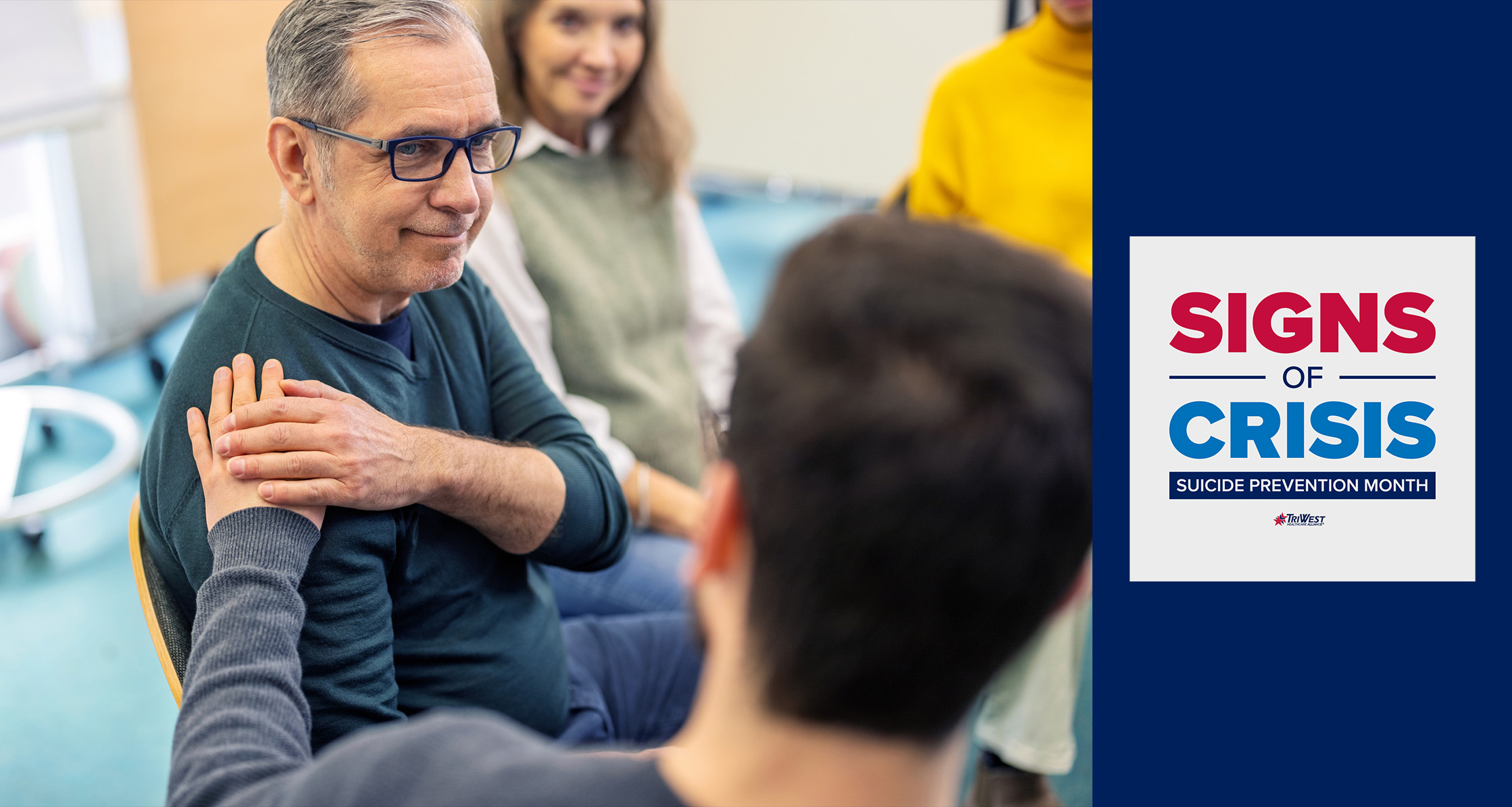TriWest Healthcare Alliance (TriWest) is committed to the fight against suicide, which often starts one conversation at a time.
Suicide is a complex public health issue that touches the lives of many people and their families. It may happen when a person is dealing with mental health problems, trauma, or other difficulties that make them feel helpless and hopeless.
More than 49,000 people die by suicide each year in the U.S. In the general population, this equates to one suicide every 11 minutes.
Statistics show that suicide rates among U.S. military personnel and Veterans have been increasing over the last decade. In fact, a study released by the Pentagon in 2024 revealed that U.S. soldiers are now more likely to die from suicide than any other cause, including combat. Veterans are 1.5 times more likely to die by suicide than the general population, with roughly 17 Veterans dying by suicide per day.
TriWest Healthcare Alliance (TriWest) is committed to the fight against suicide, which often starts one conversation at a time.
Speak Up and Take Time to Listen
“Talking about suicide makes it easier to understand, reduces anxiety, and can make it easier for the person who is struggling with hopelessness to have a conversation,” says Dr. Lori Highberger, TriWest acting deputy chief clinical officer. Knowledge, care, and compassion can make real impact.
“People in crisis often have difficulty thinking broadly and creatively about their problems and generating multiple possible solutions,” explains Dr. Blake Chaffee, TriWest vice president of integrated health care services, Behavioral Health. “Instead, they often develop a kind of ‘tunnel vision’ and fixate on self-harm as the only possible solution to their concerns, when there may be many different options available. Talking about suicide can reduce the feelings of isolation people often feel and may help them see alternatives to self-harm as solutions they previously hadn’t seen.”
Talking to young people about suicide is a chance to discuss healthy ways to deal with sadness and anger, like through art, music, writing, or exercise. It guides children around ways to reframe their thinking and see positive outcomes.
Compared to past generations, suicide rates among today’s young people are growing. According to the Centers for Disease Control and Prevention (CDC), suicide is now the second leading cause of death among people between the ages of 10-14 and 25-34, and the third leading cause of death among people between the ages of 15-24.
“One in five high school students seriously considered attempting suicide in 2023,” says Dr. Highberger. “As well, research released this summer found that suicide is rising dramatically in preteens as young as 8 years old. A growing concern is the use of social media to bully or harass peers, with 57% of bullied kids reaching the clinical threshold for PTSD on a reporting scale. It’s important to check in with your children and inquire about their mental health; ask if they are OK and listen more than speaking or advising.”
Before you can be an effective lifeline for someone struggling, it’s important for you to understand the risk factors and warning signs of suicide.
What Are the Risk Factors of Suicide?
Risk factors are circumstances that increase suicide risk. Recognizing them helps you understand that a person might be more vulnerable to suicide. In some cases, a recent stressor or sudden catastrophic event can leave a person feeling desperate and this can become a “tipping point” toward suicide. Other risk factors include:
- History of trauma or abuse.
- Bullying.
- Chronic physical illness, including chronic pain.
- A history of suicide in the family.
- Substance abuse.
- Mental health conditions.
- Easy access to lethal means including guns, knives, and drugs.
Risk factors are not the same as warning signs. Risk factors suggest someone is more likely to be at risk over time. Warning signs, like talking about wanting to die or showing extreme mood swings, indicate a more immediate concern.
“Knowing that negative risk factors are present, and protective factors are limited, would lead a person to watch more closely for warning signs,” explains Dr. Highberger.
What Are the Warning Signs of Suicide?
Suicidal thoughts can affect anyone. They signal deep emotional pain and/or an underlying mental health concern that deserves understanding, care, and professional support. It can be hard to recognize when someone is thinking about suicide, however.
“People may conceal their feelings of isolation, depression, or thoughts of self-harm, particularly if they think no one cares,” says Dr. Chaffee. “It’s important to check in with friends and family regularly. Be available to hear about what they are thinking and feeling. Some warning signs of suicide include impulsive behavior, depression, social isolation, risk-taking, giving away valued possessions, or making a will.”
Other warning signs include:
- Often talking or writing about death, dying or suicide.
- Making comments about feeling hopeless, helpless or worthless.
- Increased alcohol and/or drug use.
- Sleeping too much or too little.
- Irritability.
- Loss of interest in things they used to enjoy.
- Loss of interest in personal appearance or hygiene.
- Anxiety.
- Talking about feeling trapped or being a burden to others.
If these warning signs apply to you or someone you know, talk to them as soon as possible, especially if the behavior is new or has increased recently.
How to Start a Conversation About Suicide
Hope and resilience grow when people feel heard. However, when a suicide-related crisis occurs, friends and family are often caught off-guard, unprepared, and unsure of what to say or how to listen.
It’s important to remember that real connection can help prevent a crisis. When people feel respected and valued, they are more likely to seek help and stay connected. A simple check-in, shared story, or helpful resource can make someone feel less alone.
“Don’t avoid having a conversation around suicide with your loved one,” said Dr. Highberger. “It can be brief: For example, you could say, ‘I’ve noticed you seem down lately, and I’m a little worried about you. Would you be open to talking?’ or ‘You haven’t seemed like yourself lately, and I wanted to check in. Is everything OK? Are you thinking about dying?’”
You can approach a suicide-related crisis in the following ways:
- Be There®. Listen without judgement. Create a safe space where they can talk about their feelings openly. Avoid trying to “fix” them or dismiss their feelings.
- Ask them directly. Talk openly and honestly. Don’t be afraid to ask questions like: “Are you thinking about suicide?” or “Do you have a plan for how you would kill yourself?”
- Keep them safe. Reduce access to lethal means for those at risk. This includes guns, knives, ropes, and pills.
- Help them connect. Ask simple and direct questions. For example, “Can I help you call your psychiatrist?” This supportive presence allows them to feel seen, heard, and understood during a vulnerable time.
- Follow up. Loneliness and social isolation are strong predictors of suicide. Let them know that you are still present. Show—don’t just tell. The promise to “Be There®” is best communicated through actions that show reliability over time.
When to Seek Professional Help Immediately
Some behaviors may indicate an emergency is happening or that a person is in crisis. If you observe the following behaviors, you should immediately connect the person with professional help, such as the 988 Suicide & Crisis Lifeline, emergency medical services, or a mental health professional:
- Talking about immediate harm to oneself or others.
- Planning to attempt suicide (for example, searching online for information about how to attempt suicide).
- Acting in such an erratic manner that you are concerned about their safety.
Help Is Available
Save the number, save a life. Add the 988 Suicide & Crisis Lifeline (988) to your phone now—it could save a life later. Trained crisis counselors are available to talk 24/7/365.
- 988 Suicide & Crisis Lifeline
- Call 988 (Press 1 for Veterans)
- Chat at 988lifeline.org
Here are some other resources about suicide prevention:







